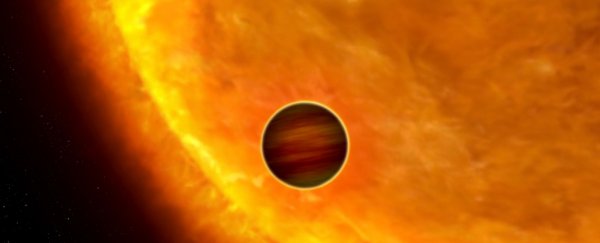We have a new record. Perhaps 1,060 light-years away, a gas giant called NGTS-10b is whipping around its star so closely, it completes an entire orbit in just 18.4 hours.
That's nearly as close as the planet can get to the host star without being ripped apart by gravitational forces. But it will get closer.
Astronomers have estimated that the exoplanet is spiralling in towards the star, and will cross that ripping-apart point - called the Roche limit - in just 38 million years. It's utterly doomed.
The finding makes this solar system an incredible laboratory for studying tidal interactions between a star and a perilously close giant exoplanet, which belongs to the 'hot Jupiter' type.
Hot Jupiters are fascinating exoplanets. As the name suggests, they are gas giants like Jupiter; unlike Jupiter, however, they orbit very closely to their host stars, with orbital periods of less than 10 days. This is what makes them "hot" (and here you were thinking it was the swimsuits).
According to current models of planet formation, technically hot Jupiters shouldn't exist. A gas giant can't form that close to their star, because the gravity, radiation, and intense stellar winds ought to keep the gas from clumping together.
However, they do exist; of the over 4,000 confirmed exoplanets discovered to date, up to 337 could be hot Jupiters. It's thought that they form farther out in their planetary systems, then migrate inwards towards the star.
We may not know much about their mysterious births, but hot Jupiters that are particularly close to their stars can tell us a lot about star-planet tidal interactions. Hence, they are among the most studied exoplanets in the galaxy.
Until this latest breakneck discovery, only six of these enigmatic gas giants had ever been detected with an orbital period of less than one day - WASP-18b (22.6 hours), WASP-19b (18.9 hours), WASP-43b (19.5 hours), WASP-103b (22.2 hours), HATS-18b (20.1 hours) and KELT-16b (23.3 hours).
NGTS-10b, discovered using the ground-based Next-Generation Transit Survey in Paranal, Chile, marks the seventh of these ultra-close hot Jupiters, and it has the shortest orbital period of them all.
Between 21 September 2015 and 14 May 2016, a single telescope observed the star now known as NGTS-10 over 237 nights. The survey wasn't officially operational yet, but it captured 220,918 10-second exposures of the star during this commissioning phase.
It seemed like a relatively unremarkable main sequence star - around 10 billion years old K-type orange star, just under 70 percent of the Sun's size and mass.
But a closer look at those images revealed that the star was dimming slightly every 18.4 hours. So an international team of astronomers led by James McCormac of the University of Warwick set to work, using that data and additional observations to characterise the exoplanet responsible for the dimming.
They determined that NGTS-10b is just over 1.2 times the size of Jupiter, and just over 2.1 times its mass. And it's orbiting the star at 1.46 times the Roche radius - meaning it's right on the verge (in cosmic time) of tidal devastation.
At such proximity to the star, even though it's not yet close enough to pull NGTS-10b apart, the exoplanet will be flattened at the poles as the star's gravity pulls it out of shape, an oblate spheroid rather than a nice, plump round sphere.
The team was careful to rule out a binary companion of the host star as a cause of the dimming. So, we are as sure as we can be that the exoplanet exists. The problem is that the light from the neighbouring stars has made it somewhat difficult to calculate an accurate distance to NGTS-10.
The 1,060 light-year distance was calculated based on Gaia data, the most accurate three-dimensional map of the Milky Way galaxy to date, but there's still a margin for error. If the distance is incorrect, that may mean some of the size and mass data is slightly incorrect, too.
That issue can be resolved by studying the next release of Gaia data, due to drop in batches in 2020 and 2021.
Meanwhile, continued observations of the system could reveal the exoplanet's orbital decay. The team predicts that the orbit will shorten by 7 seconds over the next 10 years. If astronomers can obtain precise enough measurements of the system, they may be able to see it happening.
The research has been published in the Monthly Notices of the Royal Astronomical Society.
A version of this article was originally published in October 2019, when the study was available in pre-print.
